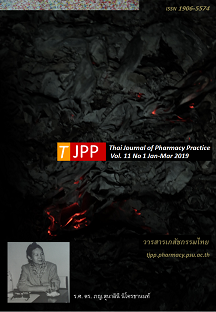การใช้ยาด้วยตนเองในอาการเจ็บป่วยเล็กน้อยของประชาชน แขวงเวียงจันทน์ สาธารณรัฐประชาธิปไตยประชาชนลาว
Main Article Content
บทคัดย่อ
วัตถุประสงค์: เพื่อสำรวจความชุกของการใช้ยาด้วยตนเองเพื่อรักษาอาการเจ็บป่วยเล็กน้อยและการใช้ยาอย่างไม่เหมาะสม และแหล่งข้อมูลในการประกอบการตัดสินใจซื้อผลิตภัณฑ์ใช้เพื่อรักษาอาการเจ็บป่วยเล็กน้อยของประชาชนแขวงเวียงจันทน์ สาธารณรัฐประชาธิปไตยประชาชนลาว (สปป. ลาว) วิธีการ: การวิจัยเชิงสำรวจแบบภาคตัดขวางครั้งนี้ทำในผู้ใหญ่ที่อาศัยในแขวงเวียงจันทน์ สปป. ลาว อายุ 20-78 ปี จำนวน 200 คน ซึ่งถูกสุ่มเลือกมาแบบหลายขั้นตอน โดยสุ่มเมืองด้วยการสุ่มแบบชั้นภูมิ สุ่มหมู่บ้าน ครัวเรือน และคนในครัวเรือนด้วยการสุ่มอย่างง่าย การศึกษาเก็บข้อมูลโดยใช้แบบสัมภาษณ์ชนิดมีโครงสร้างที่ผู้วิจัยสร้างขึ้นเองและผ่านการตรวจสอบความตรงโดยผู้เชี่ยวชาญจำนวน 3 คน ผลการวิจัย: ตัวอย่างส่วนใหญ่เป็นเพศหญิง (ร้อยละ 65.0) อายุเฉลี่ย 47±13.2 ปี ความชุกของการใช้ยาด้วยตนเองเพื่อรักษาอาการเจ็บป่วยเล็กน้อยในช่วง 3 เดือนก่อนการสัมภาษณ์เท่ากับร้อยละ 72.7 (95%CI: 65.0, 81.0) อาการที่เป็นส่วนใหญ่คือ ปวดหัว ตัวร้อน เป็นไข้ (ร้อยละ 58.1) ปวดเมื่อย (ร้อยละ 24.7) และโรคกระเพาะ (ร้อยละ 15.1) ผลิตภัณฑ์ที่กลุ่มตัวอย่างเลือกใช้ คือ ยาแผนปัจจุบัน ผลิตภัณฑ์จากสมุนไพร ยาแผนโบราณ ผลิตภัณฑ์เสริมอาหาร และวิตามิน (ร้อยละ 85.0, 19.4, 15.1, 5.4 และ 5.4 ตามลำดับ) ความชุกรวมของการใช้ยาอย่างไม่เหมาะสมเท่ากับร้อยละ 64.5 (95%CI: 55.0, 74.0) ผลิตภัณฑ์ที่มีการใช้อย่างไม่เหมาะสมมากที่สุดคือยาแผนปัจจุบัน (ร้อยละ 68.4) แหล่งข้อมูลสำคัญของการใช้วิตามิน ยาแผนปัจจุบัน และผลิตภัณฑ์จากสมุนไพร คือประสบการณ์การใช้ได้ผลในอดีต (ร้อยละ 80.0, 68.0 และ 50.0 ตามลำดับ) ของยาแผนโบราณ คือ คำแนะนำจากคนรู้จัก (ร้อยละ 50.0) และของผลิตภัณฑ์เสริมอาหาร คือ การโฆษณา (ร้อยละ 40.0) สรุป: ในแขวงเวียงจันทน์มีความชุกของการการใช้ยาด้วยตนเองและการใช้ยาแผนปัจจุบันอย่างไม่เหมาะสมที่สูง การเฝ้าระวังควรมุ่งไปที่กลุ่มยาที่ใช้รักษาอาการ ไข้ ปวดเมื่อย โรคกระเพาะ ตลอดจนควรมีการศึกษาเพิ่มเติมเพื่อทำความเข้าใจอิทธิพลของประสบการณ์ในอดีตต่อการใช้ยา
Article Details
ผลการวิจัยและความคิดเห็นที่ปรากฏในบทความถือเป็นความคิดเห็นและอยู่ในความรับผิดชอบของผู้นิพนธ์ มิใช่ความเห็นหรือความรับผิดชอบของกองบรรณาธิการ หรือคณะเภสัชศาสตร์ มหาวิทยาลัยสงขลานครินทร์ ทั้งนี้ไม่รวมความผิดพลาดอันเกิดจากการพิมพ์ บทความที่ได้รับการเผยแพร่โดยวารสารเภสัชกรรมไทยถือเป็นสิทธิ์ของวารสารฯ
เอกสารอ้างอิง
2. Katanyutanon T. Alternative medicine. Huachiew Cha- lermprakiet University Journal. 2008; 22: 68-78.
3. Mahmood A, Kushtiwala DH, Faisal A. Self-medica- tion and inappropriate drug use in geriatric popula- tion of Karachi, Pakistan. IOSR Journal of Dental and Medical Sciences 2014; 13: 66-71.
4. Oliveira MG, Amorim WW, de Jesus SR, Heine JM, Coqueiro HL, Passos LC. et al. A comparison of the Beers and STOPP criteria for identifying the use of potentially inappropriate medications among elderly patients in primary care. J Eval Clin Pract 2015; 2: 320–25.
5. Cassoni TCJ, Corona LP, Romano–Lieber NS, Secoli SR, Duarte YAO, Lebrão ML. Use of potentially inappropriate medication by the elderly in São Paulo, Brazil: SABE Study. Cad Saude Publica. 2014; 30: 1708-20.
6. Baldoni AO, Ayres LR, Martinez EZ, Dewulf NLS, Santos V, Pereir LRL. Factors associated with potentially inappropriate medications use by the elderly according to Beers criteria 2003 and 2012. Int J Clin Pharm. 2014; 36: 316–24.
7. Oliveira MG, Amorim WW, Jesus SR, Rodrigues VA, Passos LC. Factors associated with potentially inappropriate medication use by the elderly in the Brazilian primary care setting. Int J Clin Pharm. 2012 ; 34: 626–32.
8. Lee CH, Chang FC, Hsu SD, Chi HY, Huang LJ, Yeh MK Inappropriate self-medication among adolescents and its association with lower medication literacy and substance use. PLoS One. 2017 14;12(12):e0189199 Available from: doi.org/10.1371/journal.pone.0189199
9. Sibmooh N, Unchern S. Pharmacokinnetics. In: Sib mooh N, editors. Pharmacology principles and exer- cises. Bangkok: Holistic Publishing. 2009; p.36-9.
10. Porisutiwutiporn S, Hemchayat M. Influencing factors of antibiotic use behavior of clients in Khlung hospital, Chanthaburi. Journal of Prapokklao Hospital Clinical Medical Education Center 2014; 31: 114-27.
11. Sihavong A, Lundborg CS, Syhakhang L, Akkhavong K, Tomson G, Wahlstro¨m R. Antimicrobial self medication for reproductive tract infections in two provinces in Lao People's Democratic Republic, Sex Transm Infect. 2006; 82: 182–86.
12. Cochran WG. Sampling techniques. 2nd Ed., New York: John Wiley and Sons, 1963.
13. World Health Organization. Promoting rational use of medicines: core components. WHO Policy Perspec- tives on Medicines. [online]. 2002 [cited June 11, 2017]. Available from: apps.who.int/medicinedocs/pdf /h3011e/h3011e.pdf
14. National Drug System Development Committee. National list of essential medicines 2013. Bangkok; The Agricultural Co-operative Federation of Thailand, 2014; p. 16
15. Chalongsuk R, Kapol N. Communication as support in the effectiveness of drug use in the elderly. Thai Bulletin of Pharmaceutical Sciences 2011; 6: 1-15.
16. Yousif MA, Abubaker IE. Prevalence, determinants and practices of self-medication with antibiotics –a population based survey in Taif, Kingdom of Saudi Aarabiaksa. Int J Res Pharm Sci. 2015; 5: 51–6.
17. Souza LA, Silva CD, Ferraz GC, Sousa FA, Pereira LV. The prevalence and characterization of self-medication for obtaining pain relief among under graduate nursing students. Rev Lat Am Enfermagem, 2011; 19: 245–51.
18. Prakaimuntrakul W. Prevalence of and factors associated with self medication with antibiotics among population of Ubonrattana district, Khon Kaen province [independent study]. Khon Kaen: Khon Kaen University; 2010
19. Fowler, Floyd J. Survey research methods. 5th ed. Los Angeles: Sage; 2014.


